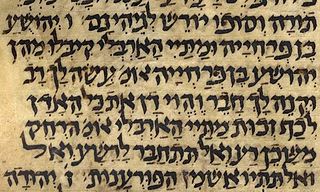
Back Hebreu d'o Mixná AN Mittelhebräisch German عبری میشنایی Persian Hébreu mishnaïque French לשון חז"ל HE Bahasa Ibrani Mishnaik ID Lingua ebraica mishnaica Italian ミシュナー・ヘブライ語 Japanese Fiteny hebreon' ny Misnà Malagasy Мишнајски хебрејски јазик Macedonian
| Mishnaic Hebrew | |
|---|---|
| Hebrew: לשון חז"ל, romanized: Ləšon Ḥazal | |
 A section of the Mishnah | |
| Region | Judaea, Syria Palaestina |
| Era | Developed from Biblical Hebrew in the 1st century CE; continued as Medieval Hebrew as an academic language after dying out as a spoken native language in the 4th century |
Early form | |
| Hebrew alphabet | |
| Language codes | |
| ISO 639-3 | – |
| Glottolog | None |
Mishnaic Hebrew (לשון חז"ל "Language of the Sages") is the Hebrew language of Talmudic texts. Mishnaic Hebrew can be sub-divided into Mishnaic Hebrew proper (also called Tannaitic Hebrew, Early Rabbinic Hebrew, or Mishnaic Hebrew I), which was a spoken language, and Amoraic Hebrew (also called Late Rabbinic Hebrew or Mishnaic Hebrew II), which was a literary language only.
The Mishnaic Hebrew language, or Early Rabbinic Hebrew language, is one of the direct ancient descendants of Biblical Hebrew as preserved after the Babylonian captivity, and definitively recorded by Jewish sages in writing the Mishnah and other contemporary documents.
A transitional form of the language occurs in the other works of Tannaitic literature dating from the century beginning with the completion of the Mishnah. These include the halakhic midrashim (Sifra, Sifre, Mekhilta of Rabbi Ishmael etc.) and the expanded collection of Mishnah-related material known as the Tosefta. The Talmud contains excerpts from these works, as well as further Tannaitic material not attested elsewhere; the generic term for these passages is baraitot. The language of all these works is very similar to Mishnaic Hebrew.
© MMXXIII Rich X Search. We shall prevail. All rights reserved. Rich X Search